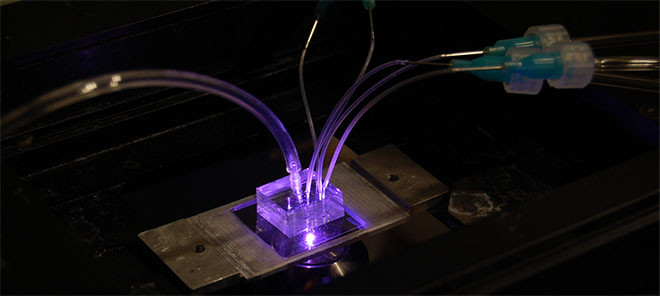
For decades, research scientists have turned to small organisms such as the worm C. elegans to better understand a number of biological phenomena, including the aging process.
C. elegans has a transparent body and each of its fixed number of somatic cells has a unique position, making it relatively easy to view under a microscope. In addition, more than 50 percent of C. elegans genes have human homologues, making it a favorite among researchers. But although C. elegans is a powerful vehicle to help scientists study aging, it can be a challenging organism to work with.
Since the aging process is so complex and heterogeneous, research demands large sample sizes in order to discern patterns and trends that are statistically significant. Achieving a high-throughput experimental platform that limits manual handling of C. elegans and enables repeatable, accurate functional imaging of large populations has been a stumbling block.
Work from the laboratory of ME Associate Professor Nikos Chronis is solving those long-standing challenges. Chronis’ work focuses on micro and nano electro-mechanical systems (MEMS/NEMS) and microfluidics technologies to address both fundamental questions in neuroscience and clinical needs in the medical field.
While conducting research into the aging process in the nervous system of C. elegans, Chronis realized he needed a more efficient way to handle the live and tiny worms — between 20 to 40 microns in diameter — in his studies. Such handling includes loading and noninvasively positioning and immobilizing a specimen, exposing it to a carefully controlled stimulus, imaging and recording the response, and releasing it.
“Microfluidics technology emerged in the 1990s and mainly has been used in research for clinical diagnostic applications and cell, protein and DNA analysis, but our own research in neuroscience highlighted the opportunity for this technology to facilitate research on live organisms,” explained Chronis.
Chronis set out to create an automated platform to simplify the experimental process. The system he developed includes two main components: a microfluidic biochip and an integrated fluorescence microscope.
The customized design and specialized microfabrication of the biochip guides worms to enter the device in the correct orientation and noninvasively immobilizes an individual worm. Once the specimen worm is in place, the device delivers a measured amount of a gas or chemical stimulus to the nose for a precisely controlled period of time. Researchers locate the cells of interest and image them to determine the target cells’ response to the stimulus. Pressurizing the device flush channel once testing is complete guides the worm to exit.
In a paper published in the journal Lab on a Chip in 2010, Chronis and collaborators in the U-M departments of Electrical Engineering and Computer Science and Biomedical Engineering demonstrated the novel platform. They also demonstrated, in vivo, functional, age-dependent changes in the nervous systems of older worms down to the single-neuron level, something that had not been achieved to date. Their findings further support the validity of previous research related to aging and neurological decline.
The microfluidic platform Chronis developed from a decade of foundational research has since led him to co-found a startup company, MicroKosmos, LLC, with Daphne Bazopoulou, a former post-doctoral research fellow in the Chronis lab. The company is based in Ann Arbor, and its mission is to accelerate breakthrough discoveries by automating experimental protocols.
To date MicroKosmos has microfabricated devices for studying C. elegans and Drosophilia melanogaster, commonly known as the fruit fly. Customized devices can be fabricated for other organisms and experimental setups.
The microfluidic platform also holds promise for the time-consuming and costly process of drug screening, which is critical to new drug discovery.
“We believe our system can be a game-changer in this arena, especially with drugs targeting the nervous system,” said Chronis. “Our platform automates many aspects of the research process, enables standardization of assays and lets researchers collect a high volume of quality data efficiently. We still have a long way to go — of course C. elegans is not human — but we’re off to a good start.”